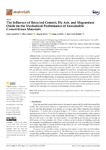Mostrar o rexistro simple do ítem
The influence of recycled cement, fly ash, and magnesium oxide on the mechanical performance of sustainable cementitious materials
| dc.contributor.author | Sequeira, Lucas | |
| dc.contributor.author | Cantero, B. | |
| dc.contributor.author | Bravo, Miguel | |
| dc.contributor.author | Brito, J. de | |
| dc.contributor.author | Medina Martínez, César | |
| dc.date.accessioned | 2023-05-25T16:06:51Z | |
| dc.date.available | 2023-05-25T16:06:51Z | |
| dc.date.issued | 2023 | |
| dc.identifier.citation | Sequeira, Lucas, Blas Cantero, Miguel Bravo, Jorge de Brito, and César Medina. 2023. "The Influence of Recycled Cement, Fly Ash, and Magnesium Oxide on the Mechanical Performance of Sustainable Cementitious Materials" Materials 16, no. 7: 2760. https://doi.org/10.3390/ma16072760 | es_ES |
| dc.identifier.uri | http://hdl.handle.net/2183/33130 | |
| dc.description.abstract | [Abstract:] In the construction industry, cement is the most widely used material. So, to achieve greater sustainability in this industry, it is imperative to improve the sustainability of this material. One way to reduce the ecological footprint of cement is to replace it, even if partially, with other more sustainable materials that can act as binders. This paper analyses the mechanical properties of more sustainable mortars containing recycled cement (RC), fly ash (FA), and magnesium oxide (MgO). Different types of binary, ternary, and quaternary mortars were used: containing recycled cement (5% and 10%), fly ash (10% and 20%), and MgO (7.5% and 15%). An experimental campaign was carried out analysing air content, density, compressive and flexural strengths, modulus of elasticity, and ultrasonic pulse velocity. The ternary mortars showed decreases between 0.4% (M-5RC10FA) and 35.3% (M-10RC15Mg) in terms of compressive strength at 365 days (compared to RM), when the theoretically expected decrease (the sum of the decreases obtained with the individual incorporation of these materials) would be between 16.6% and 41.5%, respectively. The results obtained allow for concluding that the joint use of these materials in ternary mortars improves the mechanical capacity, relative to the individual incorporation of each material in binary mortars. | es_ES |
| dc.description.sponsorship | This research was funded by the Portuguese Foundation for Science and Technology (FCT) through project PTDC/ECI-COM-31138/2017 (DecarbonCrete). The authors wish to thank Civil Engineering Research and Innovation for Sustainability (CERIS), IST and Foundation for Science and Technology (FCT). | es_ES |
| dc.description.sponsorship | Fundação para a Ciência e a Tecnologia, Portugal; PTDC/ECI-COM-31138/2017 | es_ES |
| dc.language.iso | eng | es_ES |
| dc.publisher | MDPI | es_ES |
| dc.relation.uri | https://doi.org/10.3390/ma16072760 | es_ES |
| dc.rights | Atribución 3.0 España | es_ES |
| dc.rights.uri | http://creativecommons.org/licenses/by/3.0/es/ | * |
| dc.subject | Quaternary mortars | es_ES |
| dc.subject | Recycled cement | es_ES |
| dc.subject | Magnesium oxide | es_ES |
| dc.subject | Fly ash | es_ES |
| dc.subject | Mechanical properties | es_ES |
| dc.subject | Sustainability | es_ES |
| dc.title | The influence of recycled cement, fly ash, and magnesium oxide on the mechanical performance of sustainable cementitious materials | es_ES |
| dc.type | info:eu-repo/semantics/article | es_ES |
| dc.rights.access | info:eu-repo/semantics/openAccess | es_ES |
| UDC.journalTitle | Materials | es_ES |
| UDC.volume | 16 | es_ES |
| UDC.issue | 7 | es_ES |
| UDC.startPage | 2760 | es_ES |
| dc.identifier.doi | 10.3390/ma16072760 |






